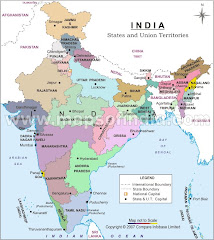The Republic of India is the seventh largest country by geographical area, the second-most populous country, and the most populous democracy in the world. India has a coastline of 7,517 kilometers and is bordered by Pakistan, China, Nepal, Bhutan; Bangladesh and Myanmar.
Four major world religions, Hinduism (80.5%), Buddhism(0.8%), Jainism and Sikhism originated there, while Zoroastrianism, Judaism, Christianity and Islam (13.4%) arrived in the first millennium CE and shaped the region's diverse culture.
India became an independent nation in 1947 after a struggle for independence that was marked by widespread nonviolent resistance.
India is a republic consisting of 28 states and seven union territories with a parliamentary system of democracy. It has the world's twelfth largest economy at market exchange rates and the fourth largest in purchasing power. Economic reforms since 1991 have transformed it into one of the fastest growing economies. But it still suffers from high levels of poverty, illiteracy, and malnutrition.
Indian Economy
The Bombay Stock Exchange, in Mumbai, is Asia's oldest and India's largest stock exchange.
With an average annual GDP growth rate of 5.8% for the past two decades, the economy is among the fastest growing in the world. It has the world's second largest labour force, with 516.3 million people. In terms of output, the agricultural sector accounts for 28% of GDP; the service and industrial sectors make up 54% and 18% respectively. Major industries include textiles, chemicals, food processing, steel, transportation equipment, cement, mining, petroleum, machinery and software.
India's GDP is US$1.089 trillion, which makes it the twelfth-largest economy in the world or fourth largest by purchasing power adjusted exchange rates. India remains one of the poorest countries in the world. The percentage of people living below the new international poverty line $1.25 a day decreased from 60% in 1981 to 42% in 2005.
Thursday, February 19, 2009
The Evolution Of Outsourcing
The idea of outsourcing has its roots in the “competitive advantage” theory has been propagated by Adam Smith. Over the years, the meaning of the term “outsourcing” has undergone a sea-change. What started off as the shifting of manufacturing goods to countries providing cheap labor during the Industrial Revolution, has taken on a new connotation in Today’s scenario. In a world where information technology has become the backbone of businesses worldwide, “outsourcing” is the process through which one company hands over part of its work to another company, making it responsible for the design and implementation of certain business process under the requirements and specifications of the outsourcing company.
Monday, February 9, 2009
Friday, February 6, 2009
Introduction To Outsourcing
- As of 2008, around 0.7 million people work in outsourcing sector (less than 0.1% of Indians). Annual revenues are around $11 billion, around 1% of GDP. Around 2.5 million people graduate in India every year, but only about 15% are suitable for employment in this sector. Wages are rising by 10-15% as a result of skill shortage.
- A business process that involves in contracting with another company to accomplish a particular task or tasks is called "Business Outsourcing". There are different types of outsourcing such as Business Process outsourcing, Offshore outsourcing, IT outsourcing, Infrastructure outsourcing, etc. It is a widely accepted methodology by all the major firms,some of them are Microsoft, IBM and Congnizant.This project mainly focuses on "IT and Offshore outsourcing".
- Information technology is nothing but the software and the hardware applications through which data transmission and storage occurs between computers anywhere on the globe.These applications are outsourced within the same geographical area or overseas.Contracting with companies overseas is called Offshore outsourcing.
Subscribe to:
Posts (Atom)


